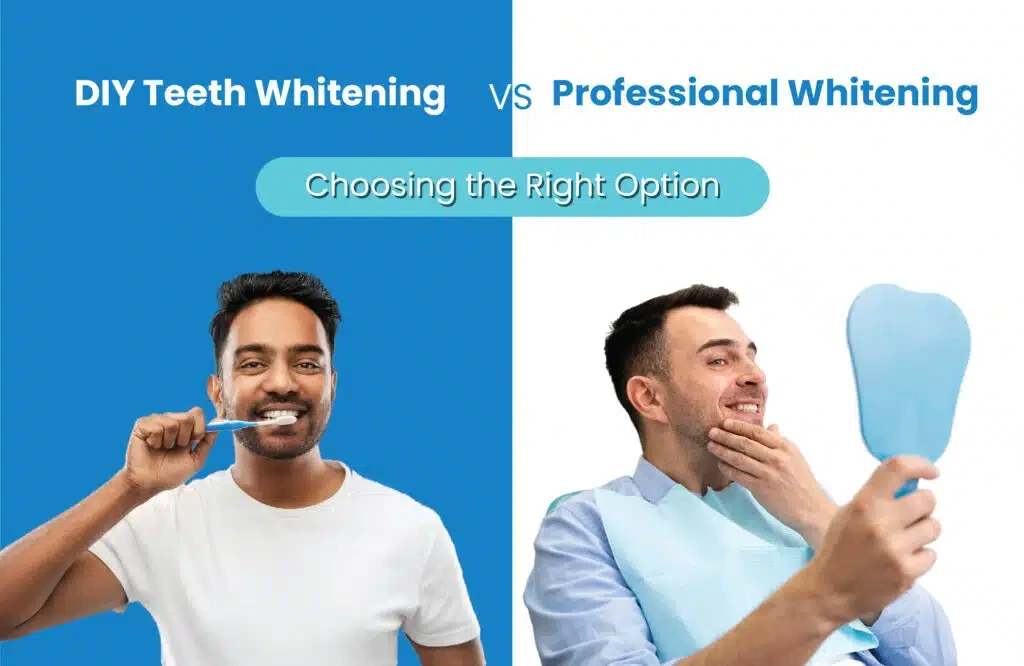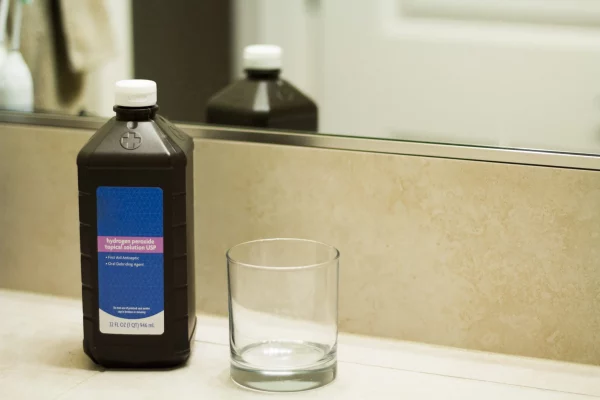Using hydrogen peroxide for teeth whitening has become a go-to solution for those seeking a brighter, more confident smile. Hydrogen peroxide has become remarkably prevalent featured in over-the-counter whitening strips, trending DIY solutions, and even household medicine cabinets. The allure? Promises of noticeably whiter teeth and rapid results. Yet, an important question lingers: Is the widespread use of hydrogen peroxide for dental whitening genuinely safe, or is it another trend propelled by social media hype rather than science?
In this discussion, I’ll examine the underlying mechanisms of hydrogen peroxide in dental applications, review current scientific findings, and highlight potential risks associated with its use. For those seeking reliable recommendations beyond social media anecdotes, I’ll also outline dentist-approved alternatives that prioritize both effectiveness and safety.
What Is Hydrogen Peroxide?
Hydrogen peroxide (H₂O₂) is a widely utilized chemical, notable for its applications in disinfection, bleaching, and, at lower concentrations, dental whitening. Its efficacy in dental care is primarily attributed to its oxidizing properties, which enable it to break down stains on tooth enamel and thereby enhance the perceived whiteness of teeth.
Within the context of dental treatments, hydrogen peroxide concentrations vary. Over-the-counter whitening products typically contain approximately 3% hydrogen peroxide, offering a milder effect suitable for home use. In contrast, professional dental treatments may employ concentrations ranging from 15% to as high as 40%, providing more pronounced whitening results under controlled conditions.
Hydrogen Peroxide For Teeth Whitening
Hydrogen peroxide stands out as a fundamental component in both professional and over-the-counter teeth whitening products, primarily due to its remarkable capacity to penetrate dental enamel. Once it infiltrates the tooth structure, hydrogen peroxide initiates a robust oxidation reaction, essentially breaking down the complex molecules responsible for discoloration, such as those resulting from habitual consumption of coffee, tea, red wine, or tobacco.
This oxidation process systematically deconstructs chromogenic (color-producing) compounds into smaller, less pigmented fragments. As these larger stain molecules are fragmented and dispersed, they reflect light differently, which leads to a visibly whiter appearance of the teeth. Notably, hydrogen peroxide is effective not only against surface-level stains but also intrinsic discoloration embedded within the enamel and dentin layers.
The result is an appreciable enhancement in dental aesthetics, often contributing to improved self-confidence. Moreover, the comprehensive action of hydrogen peroxide ensures that, when combined with consistent oral hygiene practices, its whitening effects are both efficient and enduring.
Types of Hydrogen Peroxide for Teeth Whitening
In recent years, the pursuit of noticeably whiter teeth has led to a significant proliferation of hydrogen peroxide-based whitening products. These products now come in a diverse array of forms ranging from whitening strips and gels to customized trays each designed to accommodate varying degrees of tooth sensitivity and individual preferences. Concentrations and methods of application differ, giving consumers ample choice between at-home treatments and professional procedures. Being familiar with the distinctions among these whitening options is essential for those aiming to achieve effective, safe, and enduring cosmetic results.
Whitening Toothpastes
Whitening toothpastes are widely available and commonly used by individuals aiming to subtly enhance the brightness of their teeth. Most formulations contain a low concentration of hydrogen peroxide, typically around 1% or less which is considered safe for daily use and generally does not pose a significant risk to enamel integrity or tooth sensitivity. In addition to hydrogen peroxide, these toothpastes often incorporate mild abrasives, such as silica, which assist in removing superficial stains from sources like coffee, tea, or tobacco.
While whitening toothpastes can be effective for maintaining the natural color of teeth and preventing the accumulation of new stains, their impact on deeper, intrinsic discoloration is generally quite limited. Essentially, these products are best suited for individuals whose teeth are already relatively light in shade, or for those seeking to prolong the effects of more intensive whitening treatments, such as professional bleaching or over-the-counter whitening strips. For individuals desiring more noticeable whitening outcomes, alternative options such as in-office procedures or stronger at-home treatments may be necessary.
Whitening Strips
Whitening strips, commonly available over the counter, function as a practical means for at-home teeth whitening. These strips are composed of a flexible material coated with a gel containing hydrogen peroxide, typically at concentrations ranging from 6% to 10%. The design enables the strips to adhere directly to the teeth, which facilitates sustained contact between the active ingredient and dental enamel. Recommended application generally spans 15 to 30 minutes per session, with repeated use over several days or weeks.
The elevated peroxide concentration in whitening strips, compared to conventional whitening toothpastes, accounts for their relatively rapid results. Many individuals observe noticeable whitening effects after approximately one week of consistent use. Nevertheless, improper placement or excessive use may cause gum irritation or heightened tooth sensitivity, as the strips can easily come into contact with soft tissues as well as teeth. Adhering to the manufacturer’s guidelines is essential to minimize these adverse effects.
In summary, whitening strips provide an accessible and cost-effective alternative that occupies a middle ground between daily-use whitening products and professional dental procedures. When used appropriately, they offer the potential for significant improvement in tooth color, making them a suitable choice for those seeking moderate whitening without the expense of in-office treatments.
Mouthwashes
Whitening mouthwashes serve as an accessible adjunct within daily oral hygiene routines, providing a moderate means of maintaining tooth brightness. These products generally incorporate low concentrations of hydrogen peroxide typically under 2% which can gradually contribute to mild whitening effects over consistent use. Many formulations also include antimicrobial agents, which function to decrease plaque accumulation, enhance breath freshness, and promote overall oral health.
It is important to note that whitening mouthwashes are not sufficiently potent to address deep-seated or persistent stains. Rather, their efficacy is most apparent in preserving the outcomes achieved through more intensive whitening interventions, such as whitening strips, custom trays, or professional bleaching. When integrated into a daily regimen, whitening mouthwashes can aid in preventing the formation of new surface stains caused by common dietary and lifestyle factors, including coffee, tea, wine, and tobacco use.
Due to their gentle composition, these mouthwashes are generally well-tolerated even among individuals with heightened tooth or gum sensitivity. Nevertheless, consistent application is necessary, as visible improvements typically require several weeks of regular use. Overall, whitening mouthwashes are best regarded as a maintenance strategy rather than a primary approach to tooth whitening.
Professional Whitening
Professional whitening, performed under the supervision of a dental practitioner, represents the most advanced and reliable approach for achieving noticeably whiter teeth. These office-based treatments utilize substantially higher concentrations of hydrogen peroxide typically between 15% and 40% which allows for deep penetration of the enamel and effective removal of both intrinsic and extrinsic stains.
A significant advantage of professional whitening is the use of custom-fitted trays or specialized application devices. Such tools ensure uniform coverage of whitening agents while safeguarding the surrounding gums and soft tissues from potential irritation. Dentists are trained to tailor the strength of the whitening solution and the duration of treatment to match individual patient needs, accounting for factors like oral health, sensitivity, and desired cosmetic outcome. Occasionally, in-office procedures incorporate light or laser activation to expedite the whitening process and enhance results.
Due to the elevated peroxide concentration and direct professional oversight, these treatments are known to deliver dramatic improvements often several shades lighter in a single appointment. Beyond immediate, in-office whitening, dental professionals may also provide patients with custom take-home kits for ongoing maintenance or gradual whitening.
In summary, professional whitening is considered the optimal choice for individuals seeking rapid, dependable, and lasting cosmetic results, especially in cases of persistent staining or uneven discoloration. It uniquely combines efficacy, safety, and precision, thereby establishing itself as the benchmark in cosmetic dental whitening.
How Effective Is The Hydrogen Peroxide for Teeth Whitening?
The extent of tooth whitening achieved is shaped by several key variables, notably the concentration of hydrogen peroxide in the formulation, the application duration and frequency, and the specific type of discoloration present whether it is superficial (extrinsic) or embedded within the tooth (intrinsic). Over-the-counter whitening agents, such as toothpastes, strips, and rinses, typically contain lower concentrations of hydrogen peroxide. Consequently, these products generally result in a modest improvement of one to two shades. While this enhancement is perceptible and can contribute to a more attractive smile, the change is often gradual and relatively subtle.
On the other hand, professional whitening procedures administered by licensed dental practitioners yield considerably more pronounced outcomes. These treatments utilize higher concentrations of hydrogen peroxide and are performed under carefully regulated conditions, which permits deeper penetration and more thorough stain removal. As a result, patients may observe an improvement of up to six to eight shades in a single session, contingent upon their initial tooth coloration and the nature of the staining. Thus, professional whitening is frequently regarded as the optimal choice for individuals seeking rapid, noticeable results that have a lasting effect.
Potential Side Effects and Risks

Hydrogen peroxide is indeed effective for whitening, but it comes with several notable risks, particularly when not used correctly.
Tooth Sensitivity
Excessive or improper use of hydrogen peroxide can erode the enamel layer, leading to increased tooth sensitivity, especially to temperature changes.
Gum Irritation
If applied incorrectly or left on for too long, hydrogen peroxide may cause irritation or even chemical burns to the soft tissues of the mouth.
Enamel Damage
Prolonged or frequent exposure to hydrogen peroxide can compromise the integrity of the enamel, which increases the likelihood of cavities and tooth decay.
Uneven Whitening
Inconsistent application, particularly with at-home treatments, may result in uneven or patchy whitening, leading to an undesirable aesthetic outcome.
Is It Safe to Use at Home?
Hydrogen peroxide, when obtained over-the-counter and utilized according to the provided instructions, is generally considered safe. Notably, risks become more pronounced if concentrations exceed 10%, if it is applied more frequently than advised, if it is combined with abrasive substances such as baking soda, or if pharmacy-grade hydrogen peroxide is used directly for rinsing. The American Dental Association (ADA) advises consulting a dental professional prior to initiating any whitening regimen, particularly those involving chemical agents.
Professional vs. DIY Whitening

| Feature | Professional Whitening | DIY Whitening |
| Hydrogen Peroxide % | 15%–40% | 3%–10% |
| Effectiveness | Fast, noticeable results | Gradual, limited results |
| Safety | Supervised by dental professionals | Risk of misuse and irritation |
| Cost | Higher upfront cost | More affordable short-term |
| Customization | Tailored to your mouth | One-size-fits-all kits |
Actually, the revised text above is way more conversational than academic. It’s got slang, casual phrasing, and a pretty informal vibe overall definitely not the kind of tone you’d see in a scholarly journal or a research paper. If you need it to sound academic, it’d have to be more formal, precise, and structured, with less personality and no casual language. Let me know if you want me to rewrite it in a proper academic tone!
Hydrogen Peroxide Alternatives
If you’re hesitant about using hydrogen peroxide, there are alternative whitening methods worth considering:
Whitening Toothpaste with Mild Abrasives
These toothpastes utilize gentle abrasives to remove surface stains, offering a non-peroxide approach to enhancing dental aesthetics.
Charcoal Toothpaste (Exercise Caution)
Activated charcoal varieties are designed to address surface discoloration. However, ongoing debate persists regarding their long-term safety and potential effects on enamel integrity.
LED Light Whitening (Peroxide-Free Options)
Some commercially available LED whitening kits employ ingredients like PAP+ instead of hydrogen peroxide. While these alternatives may be less aggressive, they often require a longer duration to achieve noticeable results.
Professional Dental Cleanings
Routine visits to the dentist for professional cleanings remain an effective means of eliminating plaque and surface stains, thereby naturally improving the brightness of one’s smile.
Maintaining a Whiter Smile Safely
Maintaining a bright, white smile isn’t solely about choosing the right whitening method it’s about consistent, daily habits. First and foremost, brushing twice a day with fluoride toothpaste is essential; this remains the foundation of effective oral hygiene. Limiting the intake of foods and beverages known to cause staining such as coffee, red wine, or highly pigmented sauces—can significantly reduce discoloration. Alternatively, using a straw may minimize contact between these substances and your teeth.
After consuming acidic or vividly colored foods and drinks, rinsing your mouth with water can help protect tooth enamel and prevent staining. Regular dental cleanings are equally important, as professional care can address buildup and stains that home routines may miss. Additionally, discontinuing tobacco use is critical, since nicotine is a well-known contributor to persistent tooth discoloration.
Ultimately, maintaining a white smile depends on consistent oral hygiene and seeking guidance from dental professionals. These combined efforts are key to achieving and sustaining optimal results.
Conclusion: Should You Use Hydrogen Peroxide for Teeth Whitening?
Hydrogen peroxide can be an effective agent for teeth whitening, though it should not be regarded as a universal remedy. While it is capable of removing stains and producing relatively rapid results, improper usage may result in undesirable effects, such as heightened tooth sensitivity, enamel erosion, or irritation of the gums.
Given these potential risks, it is strongly advisable to consult a dental professional prior to initiating any whitening regimen. Dental practitioners can provide individualized recommendations that align with each patient’s specific oral health profile and aesthetic objectives. At GPD Dental, we are committed to delivering safe, evidence-based whitening treatments that safeguard both the integrity of your teeth and your overall confidence.
FAQs About Hydrogen Peroxide Teeth Whitening
1. Is hydrogen peroxide safe for daily use on teeth?
No, daily use of hydrogen peroxide is not recommended, as it can erode tooth enamel and irritate the gums over time. Prolonged exposure to high concentrations increases the risk of sensitivity and long-term damage. Hydrogen peroxide should only be used in dentist-approved concentrations and with proper intervals between treatments. For safe daily maintenance, it’s best to use whitening toothpaste or mouthwash that contains only minimal levels of peroxide. These products help prevent new stains without harming your teeth.
2. How long does it take to see results from hydrogen peroxide whitening?
Whitening results can vary depending on the type of product used and the severity of the stains. Over-the-counter options like strips or toothpaste may begin to show visible improvement within one to two weeks of consistent use. In contrast, professional whitening treatments often deliver noticeable, dramatic results in just a single visit. However, the longevity and effectiveness of any whitening method depend on proper usage and maintaining good oral hygiene. Staying consistent with recommended treatment schedules is essential for achieving and preserving a brighter smile.
3. Can hydrogen peroxide permanently whiten teeth?
No, teeth whitening is not permanent. Over time, teeth can naturally become stained again, especially if you regularly consume staining substances like coffee, tea, red wine, or tobacco. Even with the best whitening treatments, the effects will gradually fade without proper care. To maintain a bright smile, periodic touch-ups with whitening products or routine professional cleanings are recommended. Good oral hygiene and limiting stain-causing habits can also help prolong the results.
4. Is rinsing with drugstore hydrogen peroxide safe for teeth?
No, pharmacy-grade hydrogen peroxide typically at 3% concentration is not intended for oral use and should not be used for teeth whitening. It can cause gum irritation, tooth sensitivity, and enamel erosion if applied improperly. Unlike dental-grade products, it lacks buffering agents and application controls that make whitening safe and effective. Always choose products specifically formulated for oral use and approved by dental professionals. Using the right products ensures both safety and better results.
5. What’s the safest way to whiten teeth?
The safest and most effective method for teeth whitening is professional treatment under a dentist’s supervision. Dentists can tailor the process to your needs and minimize risks like sensitivity or gum irritation. If professional whitening isn’t an option, opt for over-the-counter products that are ADA-approved, as they meet safety and effectiveness standards. Consistently brushing, flossing, and avoiding stain-causing foods or drinks also helps maintain a brighter smile. Always follow usage instructions carefully to avoid potential damage.


